East Wallonia July 4-6, 2018
Composed of the three provinces of Namur, Liège, and Luxembourg, Belgium’s southeastern corner is full of meandering rivers, cave systems, forested hills, and deep valleys. Castle-topped medieval towns overlook sweeping bends of the river. It is Belgium’s best place for outdoor activities, especially in the northeast. A car is necessary to appreciate the area to its fullest. French is the only language with German in the area around Eupen.
NAMUR (pop 110,000)
Namur is the capital of Wallonia and hosts the nondramatic parliament in an old hospice building. Its raison d’etre is its location at the confluence of the Meuse and Sombre Rivers lorded over by Europe’s biggest fortress. It has a picturesque old core.
History. Celts and Romans had military camps here and in the Middle Ages, the counts of Namur built a well-protected castle on the rocks overlooking the river junction. Strengthened by the Spanish in the 1640s, it was captured by the French in 1692, and then redesigned as a textbook fortress by Louis XIV’s renowned military engineer Vauban. Razed and rebuilt again thereafter, by WWI it was considered impregnable, yet it fell to the Germans in 3 days. In WWII Namur was bombed heavily causing extensive damage. The citadel was in military use until 1972.
Citadel de Namur. It covers the entrée hilltop with ramparts, tunnels, and grey walls. What you see now is more 19th and 20th centuries than the medieval. It is great for strolling and its tremendous views. Most open areas including the rampart footpaths are accessible at any time. Access via stairs at the point near the confluence of the rivers.

Terra Nova in the center is a 19th-century former barracks with a visitor center and museum. The Souterrains are a web of dripping, barrel-vaulted tunnels that once held the majority of key installations underground. Tours involve about 250 steps and temperatures around 13°C. €11 for the museum, Souterrains, and the toy train. Above them are the Chateau and an art deco Stade de Jeux with a sports ground in front. Take the road or trails down the west side of the citadel and cross the Sambre River back into town at the Pont de l’Evèche.
Eglise St-Loup. A former chapel of the Jesuit College built in 1626-45, this is a spectacular church inside. The red marble columns on black marble bases support black marble arches. The woodwork in the communion bench, confessionals, and pulpit are extraordinary. The ceiling is sculpted by Maastricht tufa.


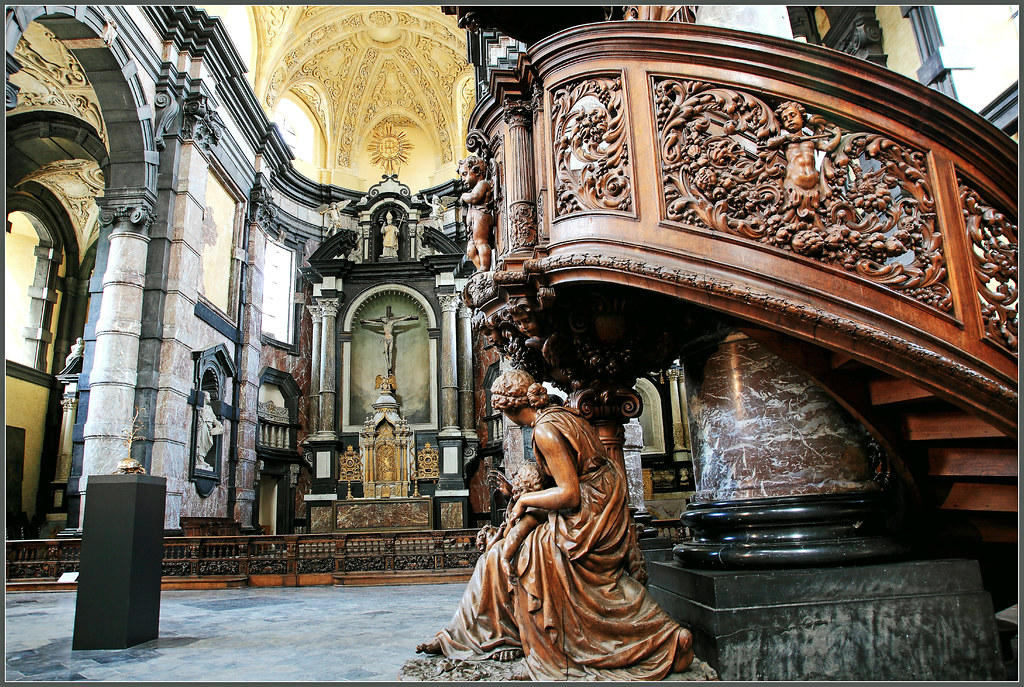
Place d’Armes. The central square has been marred by a 1980s department store but still features the elegant stone and brick Palais des Congrès, rebuilt in the 1930s with war reparations from Germany (the German army torched the entire square in 1914). Behind lies the medieval round Belfroi tower with an 18th-century clock spire.

Museum of Archaeology. In the Halle al’Chair building, a former 16th-century meat market, it is one of the few structures to have survived Namur’s history of continual wartime bombings. The museum itself has a lot of pottery, stone axes, and brass clips but also some interesting glass. Free
Burdinale & Mehaigne National Park. NE of Namur, this shows it doesn’t take much to be an NP in Belgium. It has 3 components: Parc Naturels, a tiny grove of trees and a fruit orchard; Museum and Interpretive Centre and Patrimoine Historique, the Chateau Féodal de Moha. Maybe I missed something. www.burdinale-mehaigne.be
I then had a drive about through the pretty countryside south of Namur to see a bunch of small towns and a monastery. A tip is to buy gas in Namur, it is very expensive south of here.
Crupet. A NM small town, it is a tiny lovely village with a stone church and Château des Carondelet, a moated 13th-century tower house (private and being renovated when I was there). I slept in the lot of a restaurant, famous for its trout dishes.
DINANT (pop 14,000)
History. From the 12th century, this was a major center for a form of Mosan copper and brass work still known today as Dinanderie. That ended in 1466 when the town was virtually destroyed by Burgundian King Charles the Bold because some townsfolk had dared to call him a bastard. Naming the Bishop of Liège as Charles’s illegitimate father didn’t help. In WWI, about 10% of the population was executed and much of the town was razed in retaliation for resisting the German occupation. One of its claims to fame is as the birthplace of Adolphe Sax (1816-1894) who invented the saxophone and a wide range of musical instruments but died penniless after a decade of legal wrangles.
It is easy to understand why this is a heavily touristed town – it has a lovely setting on the Meuse River sitting under spectacular cliffs. Streets, restaurants and huge brightly painted saxophones adorn everything. This is a NM small town.
Église Notre-Dame. Sitting right under the rock face, the current church was built when part of the cliff fell away and destroyed the old one in 1227. The distinctive bulbous spire was added in the 16th century. Inside the highlights are a 1671 silver/jewel bust of St Peipete, several brass candlesticks, and a massive stained glass window in the south transept. Free
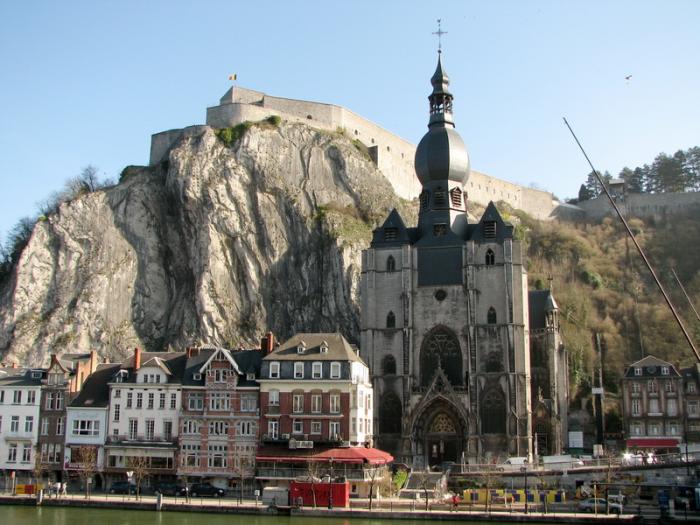
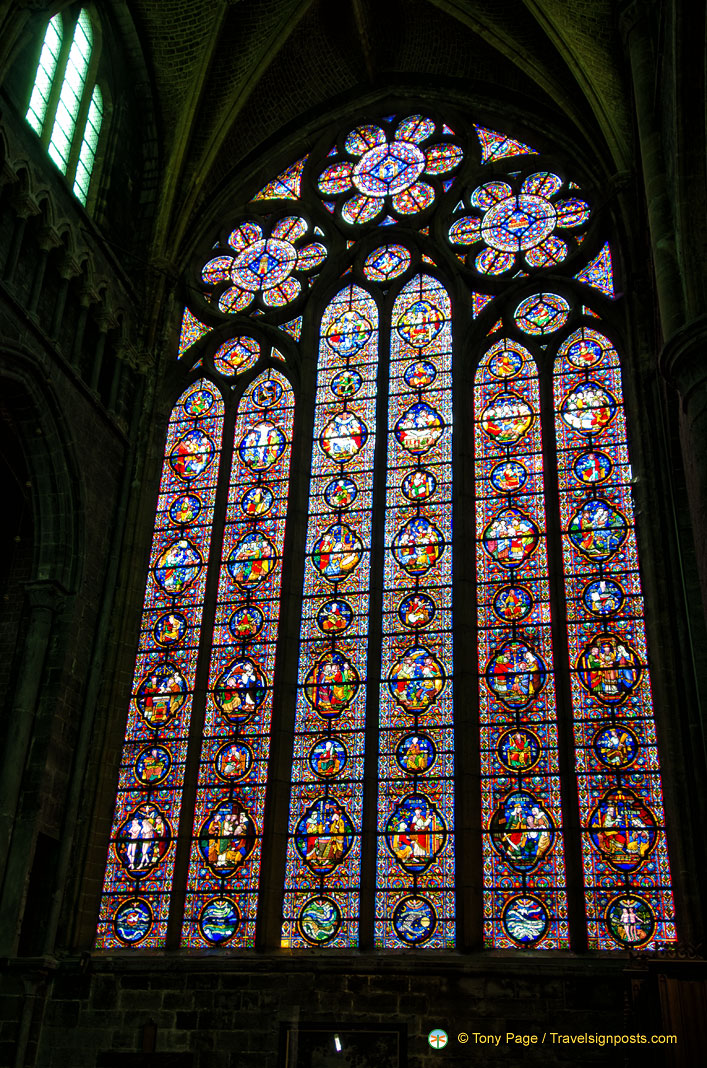
Citadelle de Dinant. This vast 1818 citadel looms on the clifftop directly above the church. The trapezoidal walls enclose large grassed areas around a central pentagonal courtyard. The only reason to come are the panoramic views.
It is accessed by 408 steps or a 1954 cable car beside the church. €8.50 for both
La Maison de la Pataphone. Near the church, this small house was occupied by religious administrators till the end of the 18th century and, if I translated French correctly, the birthplace of Adolphe Sax. It is one of the rare half-timbered houses left in Dinant. It was converted into this Maison in 2000. The mission oddly states: This is not a museum or school or information center but an eccentric, magical place for curious ears.
Maison Leffe. Above the river on the opposite side, this previous monastery of the Dominican sisters (1902-91), it is now a hotel owned by Infiniti Resorts (€125 basic, €175 luxe room). The walls are lined with red monochrome religious paintings beside the glass-roofed restaurant.

MONASTERE DE CHEVETOGNE.
I am glad I made the big detour to this Benedictine monastery consecrated as recently as 1957. The entire inside was painted over 7 years by Greek artists (all the script is in Greek). The nave is Old Testament with saints under bible stories and the altar area is New Testament. Unfortunately, the altar portion was full of scaffolds as the paintings were being cleaned. I talked to a South African monk who told me some of the stories. There was a conference being given by a Hindu and I listened in for an hour. The audience was assiduously taking notes on this man’s view of Hinduism and Christianity. I would have loved to ask questions.

![]()
Rochefort (pop 12,500). This is a pleasant regional base for exploring the countryside around. It has several caves that are less well-known. It is famous for Trappist beer made by the Abbaye de St-Rèmy, 3kms north.
Durbuy. A NM small town, it sits on a river and has a pretty old town full of stone buildings, but is full of tourists and restaurants. The private Château d’Ursel dominates the area.
Chardeneux. Another NM small town, this tiny village is difficult to understand in addition to the series. It has nice stone houses but there is nothing here. The tiny stone church has the list of the four parishes visited on a rotating basis by the priests implying a dirth of priests but also the small congregations (Chardeneux was the first Sunday of the month).
Château de Modave. This is an outstanding chateau on 450 hectares of a nature reserve, reached down a long lane through the forest. The most arresting of the well-preserved stucco ceilings is the heraldic relief (knights and crests) that covers the entrance hall. There are another 20 majestically furnished rooms and bed-alcove. The walls are wood-panelled and covered with tapestries and paintings. From the balcony look down a 60m cliff to a pretty rural stream. There’s no hint of this topography from the front – all gardens and an extensive grey-stone fortified farm, part of which is a high-end hotel and restaurant. €7
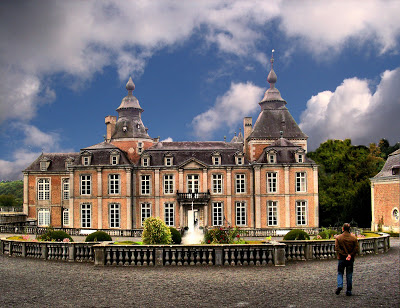
LIEGE (pop 200,000)
Wallonia’s largest city has great architecture, museums, and churches. The Meuse River flows through the center of the city.
History. Bishop of Tongeren-Maastricht, St-Lambert was murdered at a chapel here in 705 by enemies from an opposing clan. Miracles and pilgrimages ensued and donations from visitors such as Frankish emperor Charlemagne allowed the development of St-Lambert’s Cathedral, then one of the greatest in northern Europe. The prince-bishops of Liege (mini-popes) maintained the area’s independence for almost 8 centuries building many religious architectural masterpieces. Enlightened, they allowed many personal liberties; broad-minded plus Crusader-purloined Arabic scientific texts gave a technological edge to local industry from metallurgy to distillation. In the 1789 Revolution, Liegoise Liege ousted the prince bishops and demolished St-Lamberts Cathedral in 1793, a symbol of the hated rulers. Liege was then annexed by France.
After Waterloo in 1815, the territory was passed to the Dutch king and English-influenced steel production ushered Liege into a new industrial age that really only ended in 1970. WWI saw Liege become the world’s first city to suffer aerial bombing by Zeppelin airships. The 12-day holdout gave the rest of Europe just enough time to prepare a defence for Germany’s westward march.
On July 5, I had a big day in Liege seeing all the NM sites listed. I was lucky to find free parking and slept overnight in an area between the two sides of Boulevard d’Avroy. I walked to all these places in order, ending up very close to my van. On the way to Archeotorium, I walked along Boulevard de la Sauveniere, once a branch of the river.
Archéotorum. This is the archaeological diggings of the foundations of St-Lamberts Cathedral, along with the remnants of a Roman villa. Not very interesting. Price included in Grand Curtius.
Former Palace of the Prince-Bishops. The façade is 16th, 18th, and 19th century and it had a neo-gothic reconstruction in 1852. It is now a provincial government building holding the justice department and only the courtyard can be entered. The courtyard has 60 columns with grotesques at their top.
Musée de la Vie Wallonia. Wow, don’t miss this museum), one of the best presented I have ever been in (even though it is entirely in French – the collections are displayed in glass cases with perfect lighting. In an adapted convent-cloister building, it explores the region’s past from 12th century Mosan metalwork to 1960s room interiors: the rooster now Wallonia’s symbol and a guillotine with the embalmed head of the last victim. Highlights are the marionette collection and the 400 stereoscopic images of old Lièges. €4 concession
Coteau de Citadel. Just east of the museum climb the wide 373 steps up the Montagne de Bueren to the former citadel to see a war memorial, 5m-tall brick fortress bastions, and panoramic views of the city. A hospital occupies the summit. From the next viewpoint, stairs and then a switchbacking path that leads to the bottom very near the church. Free

Église Collégiale St-Barthélemy. This church has Saxon-style towers and cream and cerise exterior. Inside is the famous 1118 baptismal font, a great brass bowl rescued from St-Lambert’s Cathedral, and one of the most celebrated pieces of Mosan art. It rests on oxen figures and is adorned with 5 baptismal scenes. Free

Grand Curtius. Next door to the church in a renovated mansion of a 17th-century entrepreneur (Curtius was the Latinized name of Jean de Certe 1551-1628), it unites four discrete museum collections (glass, armoury, religion, and ancient and medieval history) and tries to explain the whole history of art. It’s also is a great museum with a wealth of treasures – the glass is especially good. €5 concession
I then had a long walk along the river and crossed one of the footbridges to the Outremeuse area.
Muséum Tchantchès. Liege’s mascot is a big-nosed wooden puppet born in about 760 whose story is a thinly disguised biblical satire but who gets riotously drunk on pékèt (Walloon gin) and head-butts people. Puppet shows are included in the admission price. As all was in French, this was a hard museum to appreciate. €3
Muséum Aquarium. In the Science Museum basement, several large aquariums show a large variety of tropical and European fish. French only. Free?
La Bouverie. On the east side of the river near the tip of the island between the river and Derivation de la Meuse canal, this fine art museum sits in a lovely park. I paid to just see the permanent collection €3 and not the exhibit Viva Roma. I enjoyed the large exhibit on Flausch, a local with a cartoonish style.
Liège Guillemins Station. Just across the river from La Bouverie, Liège’s main train station is a bold design with sweeping curves that look like a vast glass and concrete manta ray. Built in 2000, it came in well over budget. The platforms are on the second floor under the huge glass roof. Trains depart for most of Belgium and southern Holland.

Cathédral St-Paul. The central cathedral has soaring vaults, an elaborate wood pulpit, colourfully patterned ceiling, and fine stained glass windows. The reliquary to St Lambert in the main church is wonderful silver, gold, and jewels supposedly holding Lambert’s skull (there are 6 other Lambert skulls elsewhere!). On three floors on the other side of the cloister is the Trésor, €4, holding many artworks, vestments, and chalices rescued from St-Lambert’s, most notably the gold reliquary of Charles the Bold who had razed the city and then presented this masterpiece of art to the cathedral. A tiny glass tube holds the finger of St-Lambert. Free
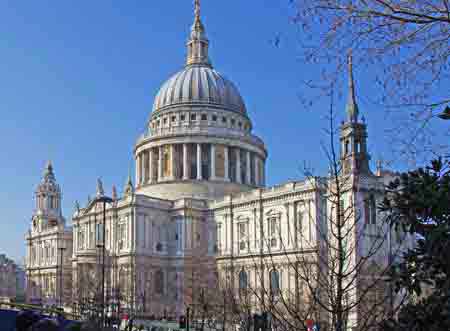

I ended up about a block from where my car was parked. What a great day. Liège is quite an attractive city. I ate and decided to continue driving. There were many places around Liège to see. I started NW and circled around heading west, then south, then north to get to the north of Liège Province to enter Eastern Flanders in its SE corner, next to the Dutch province of Maastricht.
Chateau de Waroux. 13kms NW of Liege, this small chateau is an octagonal stone castle with only a few tiny windows on its 15m wall, and a round tower. There is a farm across the highway.

Chateau de Jehay. 24 km west of Liege, this is one of Wallonia’s most photogenic sights. Like a gingerbread fantasy, this turret-spiked 1550 castle is a fabulous alternating brick and stone rising from a tree-ringed moat. The less spectacular interior consists of elegantly furnished rooms with impressive works of art. A statue of a woman riding a cricket with a man is on the grounds, along with a stable and a church. It was all being reconstructed when I was there and was closed.
Val St-Lambert. In much of Asia, Belgium’s fame is its glassware, from glasses to chandeliers. The most famous name of them all is Val St-Lambert near Seraing, whose production peaked before WWI. 90% was exported but distinctive two-color cut-glass pieces remain prized possessions in many Belgian homes. Now, production has shifted to places with cheaper labour and tastes have changed. It is often cheaper to buy an antique than a new one, especially if you don’t need a full set.
I went into the retail outlet to see the fantastic glass with fantastic prices. The most expensive piece, a large vase was €9,000. I came to the museum but the demonstration of the glass blowing was not to happen for 2 hours so I left.

SPA (pop 12,000) In the NM small town series, Spa is Europe’s oldest health resort and is the original word from which the English word derives. The warm springs were known as far back as the 1st century AD, Henry VIII visited after occupying Tournai, and it was a luxurious resort for European royalty by the 18th century. Since the 19th century, its popularity has waned. The spa is about 40kms SE from Liège.
Casino. The world’s first casino, built in 1770, is one of the grand neoclassical buildings in the center of town, along with the 1862 bathhouse (not currently in use) and the 1908 exhibition hall.
Thermes de Spa. Now the only hot springs open, this high-end spa is accessed by a steep woodland path or glass-cube pod-funicular, or by a very circuitous road.
Spa-Francorchamps Grand-Prix Circuit. Belgian’s foremost Formula I Grand Prix motor racing circuit and favourite of many drivers, it is a 5-mile track set in hilly part woodland with climbs and a dramatic 150° bend. It is 500m west of Francorchamp between Spa and Stavelot. Hotels book out and traffic is gridlocked as far away as Liège. The circuit hosts lower-profile races most weekends in the summer, some free.
I came on July 6, paid €5 for parking, and watched about 30 minutes of a race for free. There were 6 classes of cars, about 60 in all in the race. It ended suddenly when there was an accident involving 3 cars. I have never been a fan of car racing and don’t understand the excitement as usually only a small part of the race can be seen and you never really know who is in the lead.
EASTERN CANTONS
This is Belgium’s officially German-speaking area with its own German-speaking parliament.
History. It has been semi-independent since 650 and remained so until 1795. After Waterloo in 1815, Stavelot remained within the Netherlands, but Malmedy, Eupen, and St-Vith were given to Prussia and subsequently part of Germany. The Netherlands and Prussia couldn’t agree on who would get a then-valuable zinc mine (now Kelmis), so that became ‘Neutral Moresnt’ surviving until invaded by Germany in 1915.
In 1863, Bismarck declared French illegal, Eupen became thoroughly German while Malmedy spoke their Walloon dialect and remains Francophone today. After WWI, the entire Eastern Cantons became Belgian, claimed by Germany in 1937 and forced to fight for the Third Reich throughout WWII. In 1945, Americans liberated the towns and they became Belgian again.
HAUTES FAGNES. These high fens are Belgian’s largest protected reserve, a unique moorland upland plateau of swampy heath and sphagnum peat bog surrounded by woods. They are UNESCO WHS listed. Its 4000 hectares have wild boar, roe deer, hen harriers, and black grouse though you are unlikely to see any. The region is often wet, misty, and shrouded in low clouds. It is crisscrossed by paths with four main trailheads on the N676, each around 1.5km apart.
Signal de Botrange. 5kms north of Orifat, this is Belgium’s highest point, but at 694m, that is not saying much as its domed plateau looks almost flat. On the summit is a charmless stone tower and a tourist office.
Gagne de la Polleûr. This 4km loop hike is on mostly the boardwalk to avoid damaging the boggy environment.
Eupen. This city is by far Belgium’s most Germanic town and makes a useful staging point for reaching the Hautes Fagnes. It is a very normal city without much to see. Its Rosenmontag Carnival, the day before Mardi Gras lacks the weird characters of the other local carnivals but is still one of Belgium’s most colourful. Eupen houses the parliament for Belgium’s German-speaking region in an 1812 mansion.
De Commanderie. This castle is moated and looks interesting but is private with no access.
Lanaye. In the NM – XL series, this region straddles the Belgian/Netherlands border across the River. A ferry connects the two.
I then made a detour into the Maastricht area of the Netherlands just across the border to see Mheer Castle, another private chateau that can’t be visited. It sits behind a square surrounded by outbuildings.
January 26, 2019
After 4 months at home, I returned to Europe on Jan 14, seeing first the north Netherlands, some of western Germany, and Luxembourg before returning to see the very southeast part of the country next to Luxembourg.
Cross into Belgium shortly after Esch-sur-Alzette, making sure to fill up with gas first. The traffic was a disaster in Belgium as there were at least 2 detours and the roundabouts had lines kilometersd long. There is a distinct contrast between the two countries – Belgium is significantly poorer.
I was here to see the few places left in Belgium in the southeast corner of the country.
Torgny (pop 200). On the French border, this is a very cute village, the southernmost in Belgium. It owes its fame to its microclimate getting enough sun to cultivate grapes and calls itself the Provence of Belgium. A Roman villa and Frankish cemetery from the 6th and 7th centuries have been discovered here. More than 50 vintage houses are dating back to the 18th and 19th centuries – most of the buildings and homes are constructed of a yellow rough stone and have hollow roof tiles.
Torgny is also a stone’s throw from France, in particular the village of Velosnes and the fortified town of Montmédy.
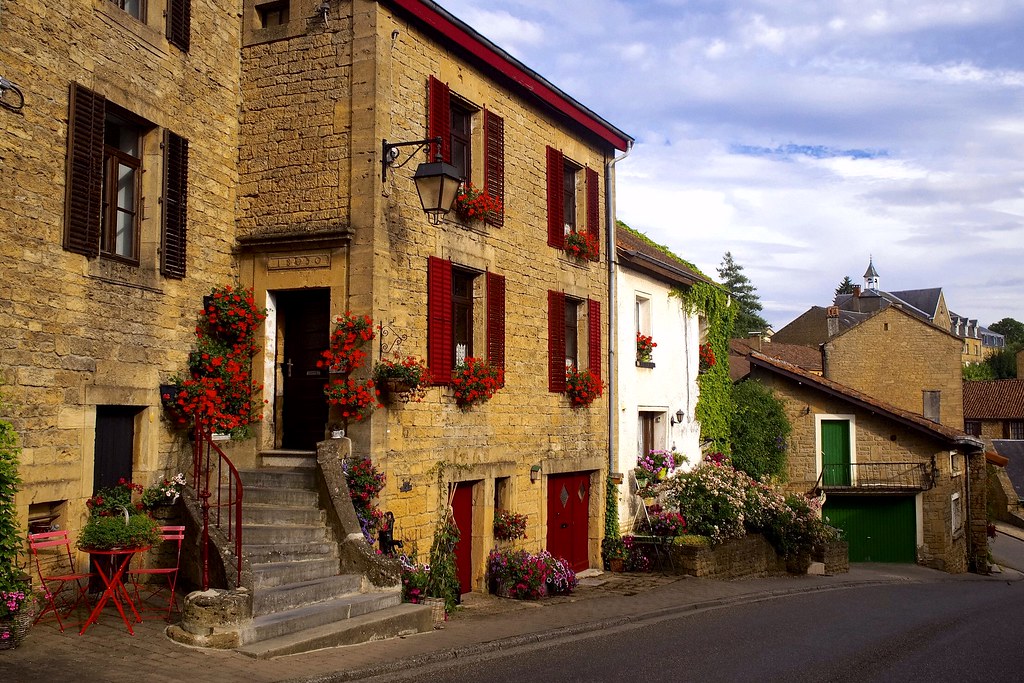
ORVAL ABBEY (Abbaye Notre-Dame d’Orval) is a Cistercian monastery founded in 1132 in the Gaume region of Belgium and is located about 12 km south of the town of Florinville. The abbey is well known for its history and spiritual life but also its local production of the Trappist beer Orval and a specific cheese.
History. The site has been occupied since the Merovingian period, and there is evidence that there was already a chapel here in the 10th century. In 1070, a group of Benedictine monks from Calabria settled here, at the invitation of Arnould, Count of Chiny, and began construction of a church and a monastery, but after some forty years, possibly because of the death of Count Arnould, they moved away again. They were replaced by a community of Canons Regular, who completed the construction work: the abbey church was consecrated on 30 September 1124. In 1132, a group of Cistercian monks from Trois-Fontaines Abbey in Champagne arrived, and the two groups formed a single community within the Cistercian Order. Around 1252, the monastery was destroyed by a fire; the rebuilding took around 100 years.
During the 15th and 16th centuries, the various wars between France and various neighbouring regions had an important impact on Orval. At one stage a foundry was established on the site. In 1637, during the Thirty Years’ War, the abbey was pillaged and burnt by French mercenaries.
In the 17th century, the abbey converted to the Trappist branch of the Cistercian order but reverted to the Rule of the main order in around 1785. In 1793, during the French Revolution, the abbey was completely burnt down by French forces, in retaliation for the hospitality it had provided to Austrian troops, and the community dispersed.
In 1887, the land and ruins were acquired by the Harenne family. They donated the lands to the Cistercian order in 1926 so that monastic life could resume on the site. Between 1926 and 1948, under the direction of the Trappist monk Marie-Albert van der Cruyssen, the new monastery was constructed, and in 1935 Orval regained the rank of the abbey with the new church was consecrated in 1948.
Retreat at the Abbey. To achieve renewal through personal and communal prayer and to withdraw for a spiritual halt, the monks at Ovral provide a guest house for individuals or groups for 2-7 days.
Trappist Brewery. Established in 1931 to finance the reconstruction of Ovral, it is very popular.
Trappist Dairy. Using an 1816 recipe, this has produced a creamy cheese that matured for 3 weeks with a naturally washed crust since 1928. Each production produces 320 blocks of 2kg each.
I explored the ruins of the original abbey and visited the main church. This is a large, very attractive (and wealthy) establishment. €8
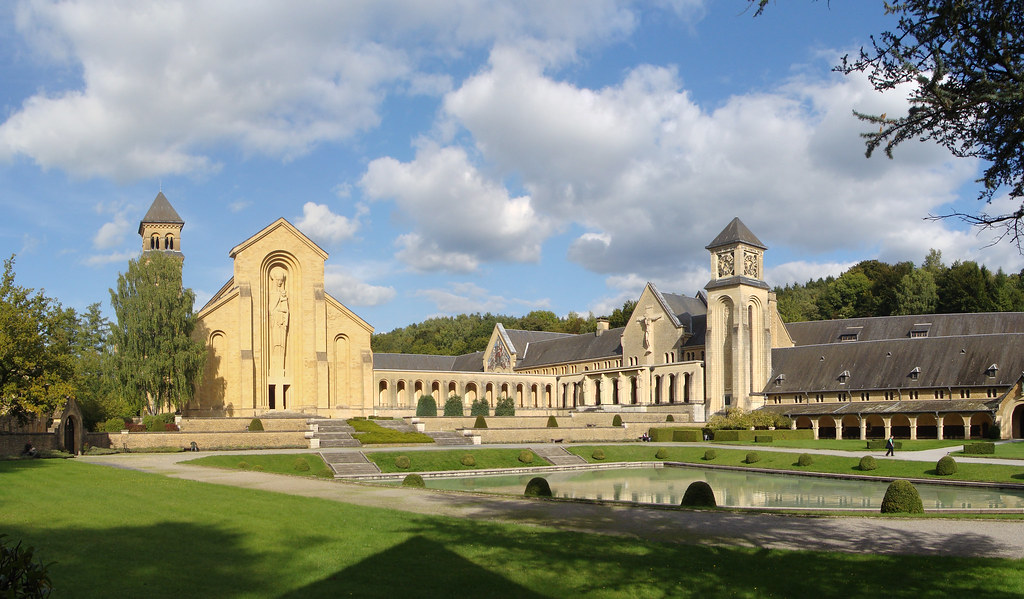

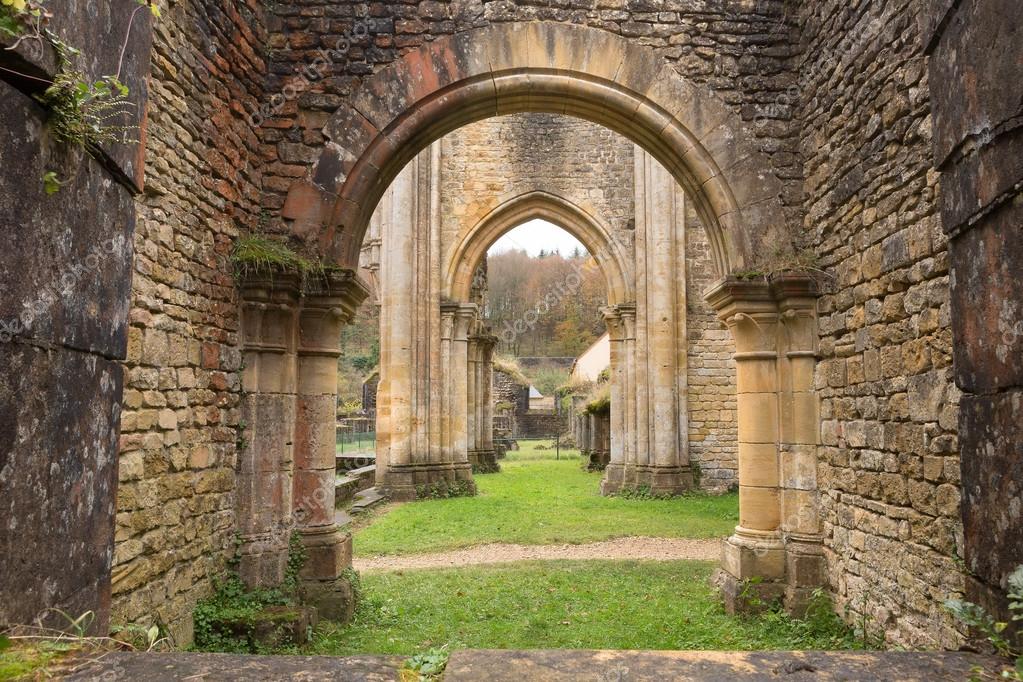
Chassepierre. (pronounced Tchespire in the Lorrain dialect) is just north of the Belgian town Florenville with the French border on its south side. The name is Chassepierre comes from Casa petrea, the Latin for “stone house”. Indeed, the houses of the village are mostly made of stones from the 18th and 19th centuries. The church of Saint Martin was built in 1702.
The village is mainly famous for its international festival of street art, more commonly known as la Fête des Artistes (literally “the Artists’ Festival”) held on the second-to-last weekend of August. This festival is the second biggest summer event in Wallonia, after Les Francofolies de Spa, an annual music festival. The festival currently gathers some 50 professional performance companies with different artists such as actors, musicians, dancers, and acrobats from all over the world. More than 30,000 visitors take part in this festival every year. In 2003, the Festival expanded to meadows situated on the other side of the river Semois. It was then possible to cross the river on a temporary footbridge. Ten years later, in 2013, a permanent bridge was built on the pillars of a former tramway bridge. In 2016, the 43rd edition of the festival took place, gathering more than 50 performance companies from Belgium, but also from The Netherlands, France, Spain, Italy, Austria, and Great Britain.